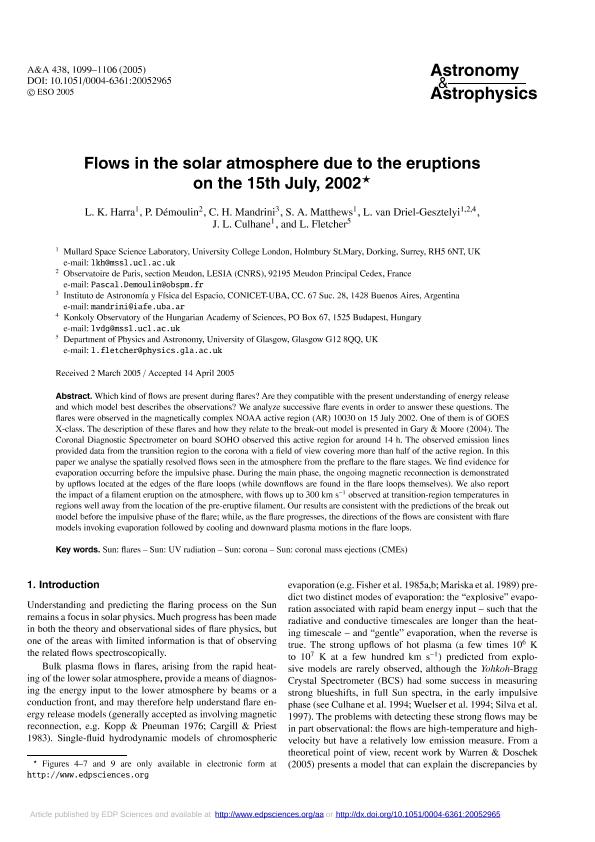Artículo
Flows in the solar atmosphere due to the eruptions on the 15th July, 2002
Harra, L. K.; Démoulin, Pascal; Mandrini, Cristina Hemilse ; Matthews, S. A.; van Driel Gesztelyi, Lidia; Culhane, J. L.; Fletcher, L.
; Matthews, S. A.; van Driel Gesztelyi, Lidia; Culhane, J. L.; Fletcher, L.
 ; Matthews, S. A.; van Driel Gesztelyi, Lidia; Culhane, J. L.; Fletcher, L.
; Matthews, S. A.; van Driel Gesztelyi, Lidia; Culhane, J. L.; Fletcher, L.
Fecha de publicación:
12/2005
Editorial:
EDP Sciences
Revista:
Astronomy and Astrophysics
ISSN:
0004-6361
Idioma:
Inglés
Tipo de recurso:
Artículo publicado
Clasificación temática:
Resumen
Which kind of flows are present during flares? Are they compatible with the present understanding of energy release and which model best describes the observations? We analyze successive flare events in order to answer these questions. The flares were observed in the magnetically complex NOAA active region (AR) 10030 on 15 July 2002. One of them is of GOES X-class. The description of these flares and how they relate to the break-out model is presented in Gary & Moore (2004). The Coronal Diagnostic Spectrometer on board SOHO observed this active region for around 14 h. The observed emission lines provided data from the transition region to the corona with a field of view covering more than half of the active region. In this paper we analyse the spatially resolved flows seen in the atmosphere from the preflare to the flare stages. We find evidence for evaporation occurring before the impulsive phase. During the main phase, the ongoing magnetic reconnection is demonstrated by upflows located at the edges of the flare loops (while downflows are found in the flare loops themselves). We also report the impact of a filament eruption on the atmosphere, with flows up to 300 km s<sup>-1</sup> observed at transition-region temperatures in regions well away from the location of the pre-eruptive filament. Our results are consistent with the predictions of the break out model before the impulsive phase of the flare; while, as the flare progresses, the directions of the flows are consistent with flare models invoking evaporation followed by cooling and downward plasma motions in the flare loops.
Archivos asociados
Licencia
Identificadores
Colecciones
Articulos(IAFE)
Articulos de INST.DE ASTRONOMIA Y FISICA DEL ESPACIO(I)
Articulos de INST.DE ASTRONOMIA Y FISICA DEL ESPACIO(I)
Citación
Harra, L. K.; Démoulin, Pascal; Mandrini, Cristina Hemilse; Matthews, S. A.; van Driel Gesztelyi, Lidia; et al.; Flows in the solar atmosphere due to the eruptions on the 15th July, 2002; EDP Sciences; Astronomy and Astrophysics; 438; 3; 12-2005; 1099-1106
Compartir
Altmétricas



